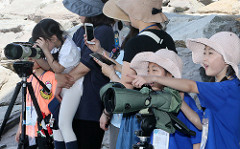CEPA Working Group
People, their decisions and actions lie at the heart of effective wetland conservation. Local communities, Site Managers, local and national government decision-makers, educators, NGOs, and the general public all have a role to play in conserving migratory birds and their wetland habitats. Encouraging and facilitating their interest and involvement in conserving migratory bird habitat for the benefit of nature and people is the key aim of the Communication, Education, Participation and Awareness (CEPA) Working Group.
Established in 2010 at the 5th meeting of the Partners, the CEPA Working Group developed a first Communication Strategy in 2012 recognising that CEPA processes need to be used at all levels within the Partnership to achieve the objectives of the EAAF as identified in the Partnership’s Implementation Strategy. This Strategy was replaced at MOP9 with the Communication, Education, Participation and Awareness (CEPA) Strategy and Action Plan 2017-2021. This document identifies a range of skills, templates, materials and activities that will contribute to the conservation of migratory waterbirds and their habitat and bring benefits to local communities. It also clearly identifies the various implementer groups who should be taking the lead in implementation.
Working Group documentation

- CEPA Strategy and Action Plan (2023-2028)
- CEPA Strategy and Action Plan (2019 – 2024)
- CEPA Strategy and Action Plan (2017 – 2021)
- CEPA Workshop report (Oct 2018)
- MOP9 CEPA Interactive Sessions report (Jun 2017)
- Communicating the EAAFP – report from the CEPA Workshop at MOP8 (Jun 2015)
- Terms of Reference (MOP6, Mar 2012)
- Terms of Reference (Dec 2022)
Working Group Chair
Mr. Casey Burns
Email: ctburns@blm.gov
Bio: Casey is the Wildlife Management and Threatened & Endangered Species Program Lead for the US Department of the Interior-Bureau of Land Management in Alaska, USA. He serves as the US representative on the Arctic Council-Conservation of Arctic Flora and Fauna (CAFF) Terrestrial Steering Group and the CAFF Mainstreaming Biodiversity into Arctic Mining initiative, and on the East Asian-Australasian Flyway Partnership Technical Subcommittee and Communication, Education, Participation, and Awareness (CEPA) Working Group. Casey is the coordinator of the Alaska Bird Outreach Group. Casey is involved in national pollinator, migratory bird, reptile, and amphibian coordination efforts. He has a MS in Conservation Biology from the University of Missouri-Saint Louis and BAs in Biology and Environmental Studies from Drury University. Casey has extensive experience collaborating to monitor, manage, and restore wildlife habitats on multiple-use landscapes.
Working Group Co Vice-Chair
Mr. Chris Rostron
Email: chris.rostron@wwt.org.uk
Bio: Chris has been working in wetland conservation and environmental CEPA activities for over 30 years. He is now based at the Wildfowl and Wetlands Trust (WWT), UK, working as the International Engagement Manager, particularly engagement in CEPA activities. For the past 12 years, he has led on WLI, the global network of wetland centres, supporting delivery of CEPA activities at wetland sites. He has worked closely with the Ramsar convention, supporting their CEPA programme, and actively engaging at their COPs, CEPA oversight panel and Standing Committees, allowing him to influence and support global wetland conservation.
Additional resources:
CEPA case studies from the flyway
- The Hong Kong Bird Watching Society (HKBWS) Fishpond Festival by Katy Chau_Hong Kong
- Training farmers at Candaba Wetlands as Bird Watching Guides by Amy Lecciones_Philippines
- Qupałuk Flyway Network Site- Outreach to Alaska Native People by Casey Burns_Alaska_USA
- The Flock Project - Pukorokoro Miranda Naturalists’ Trust, New Zealand by David Lawrie_NewZealand
- Green Holiday: A Weekend Volunteer Tour for Wetland Conservation by Hiroko Okamoto_Japan
- Wetlands and People Plan, Peel-Yalgorup System - A CEPA Action Plan for Ramsar Site 482, Australia by Kim Wilson_Australia
- Reducing Depredation of Crops by Cranes and Geese by Oleg Goroshko_Russia
- Reduction in the electrocution of birds on power lines by Oleg Goroshko_Russia
- CEPA Activities for Ramsar Site Designation of the Gulf of Mottama by Pyaephyo Aung_Myanmar
- International Cooperation in Bird Studies by Sergei Smirenski_Russia
- An Animation of Spoon-billed Sandpiper by Vivian Fu_Hong Kong
- Sister Wetlands Affiliation Programme (SWAP!) by Yang Shufen_Singapore
The collection of the CEPA case studies was initiated during the CEPA Workshop held in Oct 2018. The aim was to encourage sharing of CEPA work along the flyway and to archive successful stories. If you want to share your unique CEPA work, please download the Story-Telling Template and send to communication@eaaflyway.net.
PPT delivered at CEPA Workshop (Oct 2018)
- Amy Lecciones_Training Farmers as Birdwatching Guides at Candaba Wetlands
- Casey Burns_Outreach to the Alaska Native Community for a Flyway Network Site
- David Lawrie_The Flock
- Hiroko Okamoto_Green Holiday - A weekend volunteer tour for wetland conservation
- Kim Wilson_Peel-Yalgorup System (Ramsar Site 482) CEPA Materials
- Oleg Goroshko_Solution of the problem of the Bird electrocution in the Daurian Steppe, Russia
- Oleg Goroshko_Reduction of crop depredation by cranes and geese (Daurian steppe, Russia)
- Pyae Phyo Aung_CEPA activities for Ramsar Site designation of the Gulf of Mottama
- Sergei Smirenski_International Cooperation in Watershed Studies and Conservation
- Yang Shufen_Sister wetlands affiliation programme (SWAP!)
EAA Flyway Exhibition
East Asian-Australasian Flyway Exhibitions sets of photographs or artworks that can be displayed at Flyway Network Sites (visitor centers, city events, etc.). It is not credit-free, but helps Site Managers to raise awareness at the local level. Please contact the secretariat’s Communication Officer if you would like to exhibit in your Flyway Network Site.
- [EAAF Exhibition 1] Eat, rest, fight, socialize – just like people
- [EAAF Exhibition 2] The Migration of Red Knots
- [EAAF Exhibition 3] Shorebirds in the Flyway: The photos in the Flyway Exhibition #3 can be made available for Flyway Network Site Managers to make their own exhibitions to promote the conservation of the EAAF.
CEPA materials (see also other Working Group pages for additional CEPA materials):
- EAAFP (videos, logo, flyers, posters, hands-on materials etc.)
- Briefing Paper for Site Managers:
- A presentation on Japan’s National Partnership (EAAFP news)
- Paper animal models (2017, Ducks Unlimited Canada)
- Black-faced Spoonbill (booklet, video)
- Spoon-billed Sandpiper (video, poster)
- SBS Mask in Colour and in Black & White (developed by RSPB)
- BirdLife Australia: Ethical Birding– Factsheet for Birders (BirdLife Australia)
- Conservation India: Stop! Don’t Shoot Like that —A Guide to Ethical Wildlife Photography (2016, Shekar Dattatri and Ramki Sreenivasan)
- Ramsar Convention Secretariat: Handbook on development of wetland education centres (2014)
- Russia-USA Wetland Center: A Manual for Integrating Social Media, Data Sharing and Outreach into Public Education and Engagement at Wetland Centers (2015)
- Ramsar Convention
- CHINESE: Spoon-billed Sandpiper Migratory Game (developed by RSPB, modified and translated by Hong Kong Bird Watching Society) [Notes]
Videos:
Farewell shorebirds (BirdLife Australia)
When the conditions in the breeding grounds become very difficult due to the changing of the season birds fly to regions where conditions are better. We call this migration. Migration is the regular seasonal movement, whereby many different kinds of different birds fly over distances of hundreds to thousands of kilometers in order to find the best conditions and habitats for feeding, breeding and raising their young.
Filming Migratory Shorebirds on the Yellow Sea (Cornell Lab of Ornithology)
The Yellow Sea is located between mainland China and the Korean Peninsula. The southern part of the Yellow Sea, including the entire west coast of Korea, contains a 10 km-wide belt of intertidal mudflats. Those flats consist of highly rich benthic fauna and are of great importance for migratory waders and shorebirds. The area is the most important site for migratory birds on northward migration in the entire East Asian – Australasian Flyway.
Give beach-nesting birds a chance (BirdLife International)
Beach-nesting birds arrive in early spring to set up territories and then remain throughout the summer to lay their eggs and raise their young. The greatest threat to beach-nesting birds is disturbance from people visiting the beach. This animation shows why quietness is so important and how we can help beach-nesting birds.
Flyway animation (Common Wadden Sea Secretariat)
Migratory birds travel long distances crossing several countries during migration cycle. They often stop at suitable sites along the way to feed, breed, and rest. Conservation of migratory bird species must therefore be progressed at all important sites found on the flyways. That`s why all countries in a migration path have to work together.
The IUCN Red List: A Barometer of Life (IUCN)
IUCN Red List of Threatened Species, which assesses the conservation status of species, is widely recognized as the most comprehensive, objective global approach for evaluating the conservation status of plants, animals and fungi. This video explains about what information is provided in The IUCN Red List, how this information can be used, and how The IUCN Red List is becoming an increasingly powerful ‘Barometer of Life’.
The Ramsar Convention has published a series of videos highlighting some of the many benefits that humans can enjoy from wetlands.



